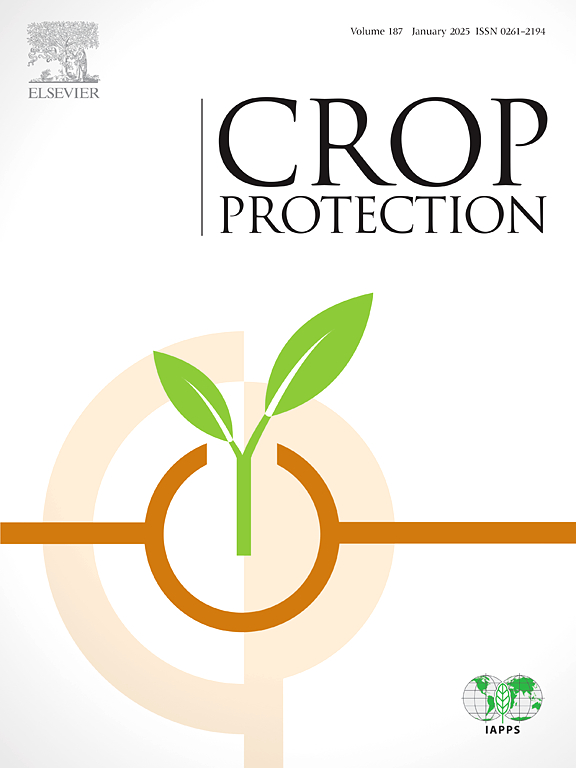Amblyseius swirskii (Athias-Henriot) (Acari: Phytoseiidae) and Streptomyces bellus E23-2 for managing Dactylopius opuntiae (Cockerell) (Hemiptera: Dactylopiidae) on Opuntia spp
IF 2.5
2区 农林科学
Q1 AGRONOMY
引用次数: 0
Abstract
Dactylopius opuntiae (Cockerell) (Hemiptera: Dactylopiidae) is a key pest of Opuntia spp., requiring effective management strategies. This study assessed the efficacy the predatory mite Amblyseius swirskii (AS) (Acari: Phytoseiidae) and the entomopathogenic bacterium Streptomyces bellus- E23-2 (SB), both individually and in combination, against D. opuntiae under both laboratory (26 °C) and greenhouse (ranging from 23.5 to 28.8 °C) conditions. Treatments included: T1 – untreated control, T2 – 0.003% Tween 80 (TW), T3 – AS alone, T4 – SB alone, T5 – SB + AS, and T6 – d-limonene (DL) (positive control). In both settings, S. bellus and d-limonene were applied at 30 mL per plant, followed by the release of predatory mites one week later. The experiments spanned five weeks. The combined treatment SB + AS demonstrated the highest efficacy in reducing egg counts (egg counts decreased to 7.78 (lab) and 7.44 (greenhouse) by week 5). Similarly, motile stages were reduced to 6.50 (lab) and 5.22 (greenhouse) per cladode. The SB treatment alone produced the highest number of mummies (42.0 in the lab, 32.9 in the greenhouse) by week 3. Predator mite densities peaked in the AS treatment (36.6 in the lab, 25.4 in the greenhouse) by week 3, with no significant difference between AS and SB + AS treatments in the greenhouse. Overall, the SB + AS treatment effectively reduced D. opuntiae populations, preserving plant health, as indicated by high visual quality scores (>9.60) by the end of the study. This integrated approach highlights the potential of combining biological agents for sustainable management of D. opuntiae on Opuntia spp.

求助全文
约1分钟内获得全文
求助全文
来源期刊

Crop Protection
农林科学-农艺学
CiteScore
6.10
自引率
3.60%
发文量
200
审稿时长
29 days
期刊介绍:
The Editors of Crop Protection especially welcome papers describing an interdisciplinary approach showing how different control strategies can be integrated into practical pest management programs, covering high and low input agricultural systems worldwide. Crop Protection particularly emphasizes the practical aspects of control in the field and for protected crops, and includes work which may lead in the near future to more effective control. The journal does not duplicate the many existing excellent biological science journals, which deal mainly with the more fundamental aspects of plant pathology, applied zoology and weed science. Crop Protection covers all practical aspects of pest, disease and weed control, including the following topics:
-Abiotic damage-
Agronomic control methods-
Assessment of pest and disease damage-
Molecular methods for the detection and assessment of pests and diseases-
Biological control-
Biorational pesticides-
Control of animal pests of world crops-
Control of diseases of crop plants caused by microorganisms-
Control of weeds and integrated management-
Economic considerations-
Effects of plant growth regulators-
Environmental benefits of reduced pesticide use-
Environmental effects of pesticides-
Epidemiology of pests and diseases in relation to control-
GM Crops, and genetic engineering applications-
Importance and control of postharvest crop losses-
Integrated control-
Interrelationships and compatibility among different control strategies-
Invasive species as they relate to implications for crop protection-
Pesticide application methods-
Pest management-
Phytobiomes for pest and disease control-
Resistance management-
Sampling and monitoring schemes for diseases, nematodes, pests and weeds.
 求助内容:
求助内容: 应助结果提醒方式:
应助结果提醒方式:


